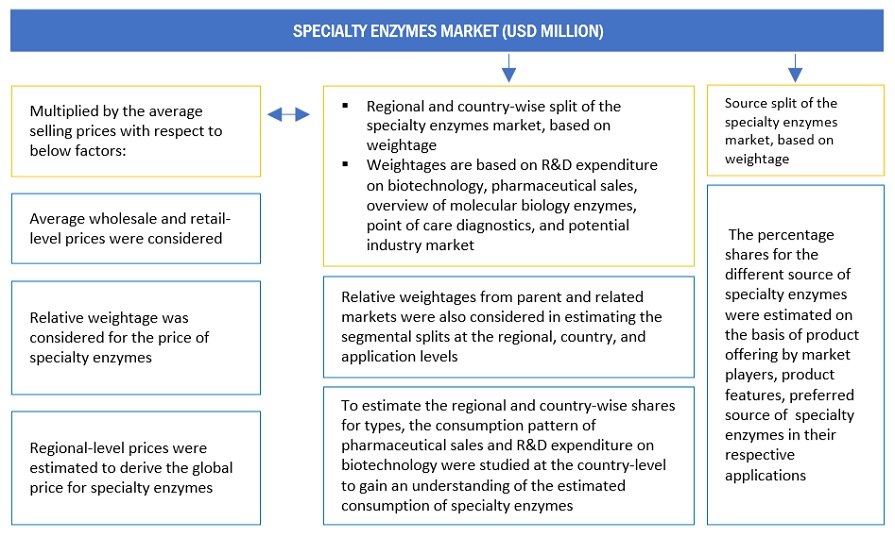This research involves the extensive use of secondary sources; directories; and databases (Bloomberg and Factiva) to identify and collect information useful for a technical, market-oriented, and commercial study of the Specialty enzymes market. In-depth interviews were conducted with various primary respondents, such as key industry participants, Subject Matter Experts (SMEs), C-level executives of key market players, and industry consultants, to obtain and verify critical qualitative and quantitative information and to assess prospects.
Secondary Research
In the secondary research process, various sources, such as the European Federation of Biotechnology (EFB), American Chemical Society (ACS), Association of Manufacturers and Formulators of Enzyme Products (AMFEP), Enzyme Technical Association (ETA), International Union of Biochemistry and Molecular Biology (IUBMB), Food and Drug Administration (FDA) , Environmental Protection Agency (EPA), European Chemicals Agency (ECHA), Food Safety and Standards Authority of India (FSSAI), Ministry of Health, Labour and Welfare (MHLW) Japan associations were referred to identify and collect information for this study. The secondary sources also include journals, press releases, investor presentations of companies, whitepapers, certified publications, articles by recognized authors and regulatory bodies, trade directories, and paid databases.
Primary Research
The Specialty enzymes market encompasses various stakeholders involved in the supply chain, raw material manufacturers, raw material suppliers, regulatory organizations, and research institutions. To gather comprehensive information, primary sources from both the supply and demand sides were engaged. Primary interviewees from the supply side consisted of manufacturers, distributors, importers, and technology providers involved in the production and distribution of Enzymes. On the demand side, key opinion leaders, executives, and CEOs of companies in the Enzymes industry were approached through questionnaires, emails, and telephonic interviews. This approach ensured a comprehensive and well-rounded understanding of the Specialty enzymes market from various perspectives.

Market Size Estimation
The top-down and bottom-up approaches were used to estimate and validate the market’s and various dependent submarkets’ size. The research methodology used to estimate the market size includes extensive secondary research of key players, reports, reviews, and newsletters of top market players, along with extensive interviews from leaders, such as CEOs, directors, and marketing executives.
Global Specialty Enzymes Market Size: Top-Down Approach

To know about the assumptions considered for the study, Request for Free Sample Report


Data Triangulation

Market Definition
Enzymes are proteins that are composed of amino acids and have the capability to convert a compound (substrate) into another product by catalytic reaction. These catalytic proteins assist in the performance of biochemical reactions. They lower the activation energy of the reaction and then induce it.
Specialty enzymes are primarily utilized to produce pharmaceuticals, and diagnostics solutions, as well as in bio-catalysts and research & biotechnology. They are highly selective catalysts and function in metabolic reactions and in the interconversion of complex molecules to smaller ones.
Stakeholders
-
Specialty enzyme raw material suppliers
-
Specialty enzyme manufacturers
-
Intermediate suppliers such as traders and distributors of specialty enzymes
-
Manufacturers of pharmaceuticals, research & biotechnology, diagnostics, and fine chemicals
-
Government and research organizations
-
Associations, regulatory bodies, and other industry-related bodies:
-
European Communities
-
World Health Organization (WHO)
-
Association of Manufacturers & Formulators of Enzyme Products (AMFEP)
-
OECD-FAO Agricultural Outlook
-
United States Department of Agriculture (USDA)
-
European Union (EU)
-
European Medicine Agency
-
European Federation of Pharmaceutical Industry Associations (EFPIA)
-
Medicines and Healthcare products Regulatory Agency (MHRA)
-
Central Drugs Standard Control Organization (CDSCO)
-
Ministry of Health, Labour and Welfare (MHLW)
-
National Medical Products Administration (NMPA)
-
Health Canada
-
Therapeutic Goods Administration (TGA)
-
Swiss Agency for Therapeutic Products (Swissmedic)
-
Brazilian Health Regulatory Agency (ANVISA)
Report Objectives
-
To define and measure the global specialty enzymes market with respect to type, source, application, and geography
-
Determining and projecting the size of the specialty enzymes market, with respect to product type, source, type, application, and regional markets, over a five-year period, ranging from 2024 to 2029.
-
Identifying the attractive opportunities in the market by determining the largest and fastest-growing segments across regions
-
Providing detailed information about the key factors influencing the growth of the market (drivers, restraints, opportunities, and industry-specific challenges)
-
Analyzing the micro markets, with respect to individual growth trends, prospects, and their contribution to the total market
-
To strategically profile key players of the global specialty enzymes market and comprehensively analyze their core competencies in each segment
-
To track and analyze competitive developments, such as alliances, joint ventures, new product developments, mergers, and acquisitions in the global specialty enzymes market
Available Customizations:
With the given market data, MarketsandMarkets offers customizations according to company-specific scientific needs.
The following customization options are available for the report:
Product Analysis
-
Product Matrix, which gives a detailed comparison of the product portfolio of each company
Geographic Analysis
With the given market data, MarketsandMarkets offers customizations according to the company-specific scientific needs.
-
Further breakdown of the Rest of the European Probiotics market, by key country
-
Further breakdown of the Rest of the Asia Pacific Probiotics market, by key country
-
Further breakdown of the Rest of South America Probiotics market, by key country
Company Information
-
Detailed analyses and profiling of additional market players (up to five)



Growth opportunities and latent adjacency in Specialty Enzymes Market